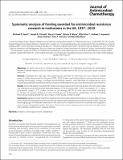| dc.contributor.author | Head, Michael G. | en_US |
| dc.contributor.author | Fitchett, Joseph R. | en_US |
| dc.contributor.author | Cooke, Mary K. | en_US |
| dc.contributor.author | Wurie, Fatima B. | en_US |
| dc.contributor.author | Atun, Rifat | en_US |
| dc.contributor.author | Hayward, Andrew C. | en_US |
| dc.contributor.author | Holmes, Alison | en_US |
| dc.contributor.author | Johnson, Alan P. | en_US |
| dc.contributor.author | Woodford, Neil | en_US |
| dc.date.accessioned | 2014-03-11T13:25:40Z | |
| dc.date.issued | 2013 | en_US |
| dc.identifier.citation | Head, Michael G., Joseph R. Fitchett, Mary K. Cooke, Fatima B. Wurie, Rifat Atun, Andrew C. Hayward, Alison Holmes, Alan P. Johnson, and Neil Woodford. 2013. “Systematic analysis of funding awarded for antimicrobial resistance research to institutions in the UK, 1997–2010.” Journal of Antimicrobial Chemotherapy 69 (2): 548-554. doi:10.1093/jac/dkt349. http://dx.doi.org/10.1093/jac/dkt349. | en |
| dc.identifier.issn | 0305-7453 | en |
| dc.identifier.uri | http://nrs.harvard.edu/urn-3:HUL.InstRepos:11879523 | |
| dc.description.abstract | Objectives: To assess the level of research funding awarded to UK institutions specifically for antimicrobial resistance-related research and how closely the topics funded relate to the clinical and public health burden of resistance. Methods: Databases and web sites were systematically searched for information on how infectious disease research studies were funded for the period 1997–2010. Studies specifically related to antimicrobial resistance, including bacteriology, virology, mycology and parasitology research, were identified and categorized in terms of funding by pathogen and disease and by a research and development value chain describing the type of science. Results: The overall dataset included 6165 studies receiving a total investment of £2.6 billion, of which £102 million was directed towards antimicrobial resistance research (5.5% of total studies, 3.9% of total spend). Of 337 resistance-related projects, 175 studies focused on bacteriology (40.2% of total resistance-related spending), 42 focused on antiviral resistance (17.2% of funding) and 51 focused on parasitology (27.4% of funding). Mean annual funding ranged from £1.9 million in 1997 to £22.1 million in 2009. Conclusions: Despite the fact that the emergence of antimicrobial resistance threatens our future ability to treat many infections, the proportion of the UK infection-research spend targeting this important area is small. There are encouraging signs of increased investment in this area, but it is important that this is sustained and targeted at areas of projected greatest burden. Two areas of particular concern requiring more investment are tuberculosis and multidrug-resistant Gram-negative bacteria. | en |
| dc.language.iso | en_US | en |
| dc.publisher | Oxford University Press | en |
| dc.relation.isversionof | doi:10.1093/jac/dkt349 | en |
| dc.relation.hasversion | http://www.ncbi.nlm.nih.gov/pmc/articles/PMC3886928/pdf/ | en |
| dash.license | LAA | en_US |
| dc.subject | antibiotics | en |
| dc.subject | antifungal | en |
| dc.subject | antiviral | en |
| dc.subject | antiparasitic | en |
| dc.title | Systematic analysis of funding awarded for antimicrobial resistance research to institutions in the UK, 1997–2010 | en |
| dc.type | Journal Article | en_US |
| dc.description.version | Version of Record | en |
| dc.relation.journal | Journal of Antimicrobial Chemotherapy | en |
| dash.depositing.author | Atun, Rifat | en_US |
| dc.date.available | 2014-03-11T13:25:40Z | |
| dc.identifier.doi | 10.1093/jac/dkt349 | * |
| dash.contributor.affiliated | Atun, Rifat | |
| dc.identifier.orcid | 0000-0002-1531-5983 | |


